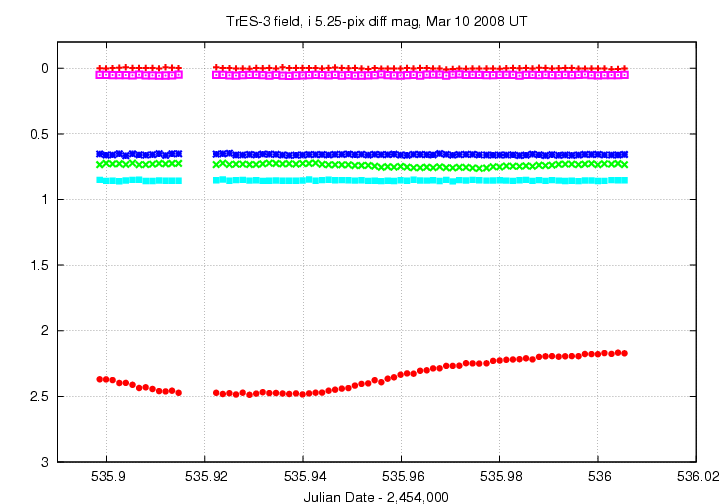
On the night of UT Mar 10, 2008, the SDSS Photometric Telescope ("PT" for short) took a series of exposures of TrES-3. We detected an entire transit. The transit is (as usual with this system) briefer than the ephemeris predicts.
Notes from the night
This is a chart of the field. TrES-3 orbits the is the bright star indicated by the crosshairs. The star labelled "C" will appear in later graphs.

The host star of TrES-3 has a magnitude V=12.40 according to TrES-3: A Nearby, Massive, Transiting Hot Jupiter in a 31-Hour Orbit .
Following the procedures outlined by Kent Honeycutt's article on inhomogeneous ensemble photometry, I used all stars available in each image to define a reference frame, and measured each star against this frame. You can find the software package used to do the ensemble photometry online; it's free!
The night was pretty clear. The graph below shows the amount by which instrumental magnitudes from each image needed to be shifted to match the ensemble reference. On a clear night, this graph would show a straight horizontal line.

Below is a graph of the scatter in differential magnitude versus magnitude in the ensemble solution.

TrES-3 is the star at differential mag 0.73. it shows a very small excess of scatter than neighboring stars of the same brightness. The "noise floor" in these measurements is about 0.003 mag -- good for the PT. Many of the outliers in the plot above are real variable stars (which were removed from the ensemble solution).
Below are the light curves for the target (green symbols) and four comparison stars in the field. I also show the light curve of one of the variables, which is at (J2000) 17:52:12.0, +37:39:07, with USNO B2.0 magnitudes B=14.5 and R=13.6. Two other interesting eclipsing binaries, both with periods of less than three hours (I think) are
USNO B2.0
B R
---------------------------------------------------------------
RA = 17:51:32.8 Dec = +37:26:42 14.8 13.4
RA = 17:51:26.3 Dec = +37:26:24 15.3 14.3
---------------------------------------------------------------

In this closeup, I have shifted the data for two comparison stars to move them closer in magnitude to the target.

In measurements on MJD 54393, we saw a little dip in the brightness before the transit. There may be a similar "little dip" here, though it's not definite.
My eyeball estimate for the start of the transit is 535.945, and my estimate for the end is 536.00.
An ephemeris grabbed from transitsearch.org predicts for this night
----------------------------------------------------------------------------------------
Begin Transit Window PREDICTED CENTRAL TRANSIT End Transit Window
All Times UT
HJD Year M D H M
2454535.93 2008 3 10 10 18 2454535.97 2008 3 10 11 15 2454536.01 2008 3 10 12 12
----------------------------------------------------------------------------------------
The ephemeris ingress of UT 2008 Mar 10 10:18:00 corresponds to JD 2,454,535.929, which is about 23 minutes EARLIER than the observed ingress. The "little dip" before my estimate of ingress might agree with this ephemeris value. The ephemeris egress of UT 2008 Mar 10 12:12:00 corresponds to JD 2,454,536.008, which is somewhat LATER than the observed egress.
This pattern confirms the indications from earlier nights,
You can grab the measurements for your own analysis. Below is a table with three flavors of time, plus the differential magnitude of the target and an estimate of the uncertainty in each measurement. I show the first few lines of the file to give you an idea of its format.
# Measurements of TrES-3 made with APO PT, Mar 10, 2008 UT. # Each exposure 30 seconds long in SDSS i-band; # Tabulated times are midexposure (FITS header time - half exposure length) # and accurate only to +/- 1 second (??). # 'mag' is a differential magnitude based on ensemble photometry # using a circular aperture of radius 5.25 arcseconds. # # UT day JD-2,450,000 HJD-2,450,000 mag uncert Mar10.89860 4535.89860 4535.89828 0.735 0.004 Mar10.89991 4535.89991 4535.89959 0.724 0.004 Mar10.90124 4535.90124 4535.90092 0.729 0.004
Last modified 03/22/2008 by MWR.